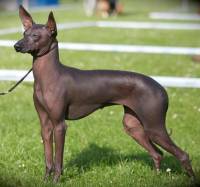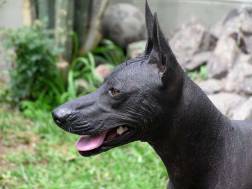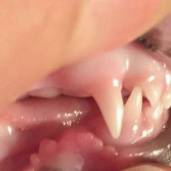Xoloitzcuintle and Peruvian Hairless Dogs
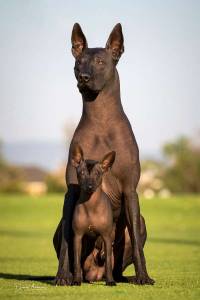 Xolo Miniature and Standard (Both Hairless)
Xolo Miniature and Standard (Both Hairless)
The isolated settlements of Central America are among the most ancient in the world, akin to the Chinese and those of Mesopotamia and Northern Africa. In a similar way to how the 'Lion-dog' was worshipped through Buddhism in China, the superstitions of the ancient civilisations of South America harboured the existence of hairless dogs.
History of the Xoloitzcuintle and Peruvian Hairless Dogs
Archaeological sites reveal numerous artefacts with carbon dating supporting the theory that hairless dogs first evolved north-west of Mexico City in approximately 1,500 BC. They needed a tropical or semi-tropical climate of Central and South America for a hairless dog population to achieve sufficient numbers to constitute a distinct breed[1].
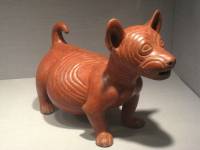 Colima Pottery Dog
Colima Pottery Dog
The famous 'Colima Pottery Dogs' dating back to the pre-Columbian Mesoamerica era of 250 BC - 450 A.D, prove that hairless dogs have been present in this part of the world since those very early days. By 800 A.D. trading occurred between the countries we know as Mexico and Peru. This would have given the Xoloitzcuintle and the Peruvian Hairless ample opportunity to transmit the hairless gene. These civilisations were isolated from the rest of the world but flourished through the Toltec and Aztec Empires until the Spanish Conquest of the Americas which began in 1492 A.D[1a].
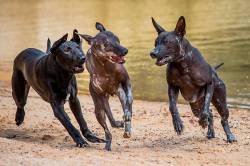 L to R: 1 Coated and 2 Hairless Xolos
L to R: 1 Coated and 2 Hairless Xolos
In 1493 A.D when Christopher Columbus landed on the Island of Santa Cruz, he described dogs as 'of a sad appearance, ugly and quite hairless which did not bark, had sparse teeth and pricked ears'. They apparently learned to bark from the European dogs brought to the region after the Spanish Conquest[3]. These dogs were used as protectors and guards of evil spirits. The offering of sacrifice and burial of dogs with their masters was supposed to guide the soul of dog's owner on his spiritual journey underground.
Hairless dogs were also used as a food source throughout Mexico and Central America where dog meat was considered a great delicacy and consumed for sacrificial rites ceremonies. In addition, hairless dogs were kept for healing powers, their skin having a palliative effect[2]. For centuries, these hairless dogs were kept alive by secluded tribes in remote parts of Mexico and Central America.
The Xoloitzcuintle becomes a Pure Breed
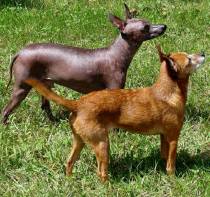 Hairless and Coated Mini Xolos
Hairless and Coated Mini Xolos
Sometimes also called the 'Xolo', the name Xoloitzcuintle is derived from 'Xolot' meaning Aztec God and 'Itzcuintle', the Aztec word for dog. The first AKC Breed Standard written by Norman Pelham Wright was accepted in 1882[1b]. Then the Federaracion Canofila Mexicana (FCM) was established with a pedigree system which began with visual inspection and a subsequent tattoo. But as registration was only accepted for hairless dogs, this was not successful because coated dogs are essential to the survival of any of the hairless breeds. Hence the necessity of coated dogs' ancestry also being recorded on pedigrees.
 Xolo Litter 3 Hairless 2 Coated
Xolo Litter 3 Hairless 2 Coated
In the 1950's, concerned about the native breed's demise, an expedition was organised. Countessa Lascelles de Premio Real represented the FCM and Mr Wright's report that the expedition had acquired sufficient new blood to replenish the breed, was widely published. Preservation breeding programmes were based upon this new indigenous stock. By 1955, the Xoloitzcuintle were first registered as only Standard and Miniature in Mexico with the FCM. From then on, Countessa Lascelles de Premio Real was influential in guiding the re-establishment of the Xolo we know today. Initially they ranged in size from approx 13" - 22" (15lb - 40 lb) with the Toy classification added in 1989 by the Canadian Kennel Club[1b]. Today, as the Xoloitzcuintle is recognised as the 'National Dog of Mexico', it is sometimes called the 'Mexican Hairless Dog'.
History of the Peruvian Hairless Dog
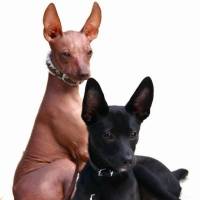 Peruvian Hairless Small Hairless and Coated
Peruvian Hairless Small Hairless and Coated
Dog remains have been excavated by archaeologists in very ancient human settlements in South America in the vicinity of what we now call Peru. These remains prove that not only did dogs exist from millennia before the birth of Christ they were an integral part of these primitive people's existence. It is not clear whether these early dogs were a food source or were the sole protectors and guards of evil spirits. But what is clear is that before the Spanish Conquest which began around 1,500 AD, modern anthropologists have confirmed that there was trade between Aztecs of Mexico and the Incas of Peru. So it is highly probable that hairless dogs were also traded. It is interesting to note that the FCM who were at the forefront of developing the Mexican Hairless into a pure breed, refused to recognise what is now the separate breed of the Peruvian Hairless.
The Peruvian Hairless becomes a Pure Breed
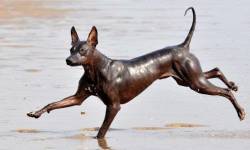 Peruvian Hairless Large
Peruvian Hairless Large
In 1980, an American, Fred Drew who lived and worked in Lima, Peru implemented the first organised breeding programme. He searched coastal villages for suitable stock and focused on larger sized stock. Dr Jose A Torre Ferrara of the Peruvian Kennel Club was later appointed to study the breed and formulate the first breed standard. This was later modified by Ermanno Maniero and accepted by the FCI in 1985. In most respects, the Peruvian Hairless Dog is very similar to the Xolo. Their differences outlined below appear to be basically because the Breed Standards of the two breeds were written at a different times by different people and were first recognised by different organisations.
Comparison between Xoloitzcuintle and Peruvian Hairless
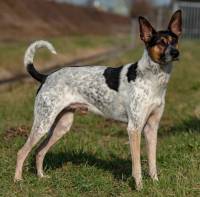 Peruvian - Large (Coated)
Peruvian - Large (Coated)
The first Xolo arrived in Australia in 2009, followed some time later by the Peruvian. Today, there are 6 Challenge Certificates for Xolos available plus 6 Challenge Certificates for Peruvian Hairless. These include one for dog and one for bitch in each of the breed 3 sizes described within the table below. Within each of these 6 classes of Xolo and Peruvian Hairless, both hairless and coated types compete. It is interesting to also note that within each variety of both Xolo and Peruvian in Australia, inter-breeding of hairless and coated varieties is permitted.
The three main differences between these two breeds are
- The body of the Xolo is slightly longer than the body of the Peruvian
- The underline of the Xolo does not have as much tuck-up as the Peruvian
- The Xolo only comes in solid colours but in the Peruvian, while solid colours are preferred, any colour is acceptable.
- The Xolo has normal front angulation whereby the Peruvian has unusual front angulation, somewhat like a 'terrier front' which causes it to move with a shorter stride than the Xolo.
| Xoloitzcuintle | Peruvian Hairless | |
| General Appearance | A slim, elegant dog with a clean outline which is moderate in all aspects. It is built for speed, harmony and strength without appearing coarse. | A slim, elegant dog built for speed, strength and harmony without ever appearing coarse. |
|
|
|
|
|
Body Proportions |
Body slightly longer than its height at withers in the ratio of 10:9. |
Body the same length as its height making it square, short or compact in the ratio of 1 : 1; |
|
Sizes (Height) |
Standard: 46 - 60 cm (18 - 23.5 ins) tolerance of +2 cm Intermediate: 36 - 45 cm (14 - 18 ins) Miniature: 25 - 35 cm (10 - 13.75 ins) |
Large: 50 - 65 cm (19.75 - 25.75 ins) Medium: 40 - 50 cm (15.75 - 19.75 ins) Small: 25 - 40 cm (9.75 - 15.75 ins) |
|
Sizes (Weight) |
Not Specified |
Large: 12 - 25 kg (26.4 to 55.1 lbs) Medium: 8 - 12 kg (17.6 - 26.4 lbs) Small: 4 - 8 kg (8.8 - 17.6 lbs) |
| Hairless |
Without hair. But there may be short, coarse thick hairs up to 2.5 cm long of any colour on the forehead but not forming a topknot, on the back neck, feet and the end of the tail. |
Without hair, only very few hairs on the head and at the extremities of the legs and the tail are admitted, and sometimes sparse hair on the back. |
|
Coat |
The hairless has a short, flat, preferably smooth coat with no undercoat all over its body but with less hair on its belly and inside the rear legs. |
The coated variety should have a smooth, short and tight coat (without undercoat). |
|
Colour |
|
In the hairless variety, solid dark colours are preferred. These may vary from black, slate black, elephant black, bluish black, the whole scale of greys and blues, or dark brown to light blonde. All colours can be either uniform or show pinkish or white spots or patches which must not cover more than 1/3 of the body. |
|
|
|
|
|
Head |
From above, the wedge-shaped elegant head can look wide because of its slightly developed cheeks. In profile, the head tapers from a perceptible occiput through to the straight muzzle with its tight fitting lips and strong, square jaws. In profile the skull and muzzle have parallel head planes with a slight stop in between. The nose should be dark in dark-coloured dogs but can be pink or brown in spotted or bronze-coloured dogs resp. A pink tongue with black markings, spots or marks is typical. It must be contained within the mouth because a paralysed tongue hanging outside the mouth is a disqualification. |
From above, the skull is broad, the cheeks moderately developed without exaggeration. In profile the balanced head has equal length of skull and foreface, with parallel head planes, a perceptible occiput and stop, a straight muzzle and tight lips. The head tapers towards the well pigmented nose the colour of which harmonises with the skin or coat.
|
| Eyes | Medium size, almond-shaped, the colour varying according to the skin/coat colour. Darker colours are preferred and both eyes should match. | The eyes must be of average dimensions, slightly almond shaped, and neither deep-set nor prominent. The colour should be in harmony with the skin or coat colour with both eyes the same colour. |
| Ears |
The fine textured pricked ears should be long, large and of fine texture and taper almost to a point. When the dog is attentive, their axis should be 50 - 80 degrees from horizontal. |
The medium length ears must be pricked and high set. They must be broad at the base, tapering almost to a point. When the dog is attentive, axis should be 50 - 80 degrees from horizontal. |
|
|
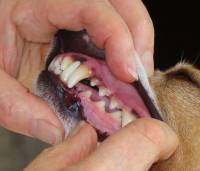 Normal Scissors Bite Normal Scissors Bite |
|
| Mouth |
Both varieties should have strong jaws, closing in a normal scissors or pincer bite. The coated variety must have full dentition (42 teeth) with normally developed and positioned teeth. However, in the hairless variety the absence of a few incisors, canines, molars, pre-molars or rotated teeth as shown should not be penalised. |
The jaws are not so strongly developed but in the coated variety all 42 teeth including the incisors must be complete and close in a normal scissors bite as shown. But in the hairless variety the absence of one or more teeth is accepted. |
| Neck |
Long and flexible, slim and slightly arched so the head is carried high, with no dewlap. |
Approximately the same length as the head with upper line curved with no dewlap |
| Forequarters |
The flat, well laid shoulder blades have normal scapula-humeral angulation which allows a long, free and elegant stride. The elbows fit closely to the chest. The forelegs seen from the front are straight ending in flexible pasterns which slope slightly into hare feet. |
The angle between the well laid shoulder blade and upper arm is unusually more than 90°, the Breed Standard quoting 100° - 120°. Despite this 'Terrier Front', the front legs should be perfectly straight, ending with well sloped pasterns and hare feet. |
| Chest | The chest is long and deep, reaching the elbows but the sternum should not protrude. Although the ribs should be well sprung they should neither be exaggerated, nor flat. | The chest should almost reach the elbows and the ribs slightly sprung but never flat. |
| Body |
The strong body should be have a straight, firm and level topline, with slightly rounded croup. The underline should be a graceful line with a moderate tuck-up. |
The muscular, well built body has a level topline curving over to the flexible croup. The underline is elegant and well tucked up. |
| Hindquarters |
The hindquarters should be strong and well-muscled with a moderate turn of stifle and short hocks to permit free and strong movement of the hind legs. |
The muscles of the hindquarters are rounded and elastic, with a good turn of stifle and upright hocks when viewed from behind. |
 Xolo - Standard Xolo - Standard |
 Peruvian Hairless - Large Peruvian Hairless - Large |
|
| Gait |
The Xolo trots freely with long, elegant, free flowing but springy steps, with head and tail carried high. |
The Peruvian typically moves with short steps due to the lack of normal front angulation described above. |
| Tail | The tail set should should be an extension of the croup. It is long and thin tapering from the base to the tip, nearly reaching the hock. In the hairless variety, it may have some tufts of hair, but in the coated variety, it should be completely covered with short hair. In movement, it is carried up in a curve, never touching the back but resting, it hangs with a slight curve at the end. In cold temperatures, it can placed between the legs. |
The tail is set on low. It should be of thick at the root, tapering towards the tip almost reaching the hock. When excited, the dog may carry the tail may be curved above the back line, but never in a curl. At rest, it hangs with a slight upward hook at the tip or tucked inwards towards the abdomen. In length it almost reaches the hock. |
References and Further Reading
[1] Amy Fernandez and Kelly Rhae - 'Hairless Dogs, the Naked Truth' Limited Edition Self-Published 1999. Section 2 - If Only it were True Pages 25 - 27.
[1a] ibid., Section 3 - Early History - The original Hairless Dog. Pages 44 - 47
[1b] ibid., Section 5 - Development of the Three Individual Breeds Page 71 - 99
[2] Brenda Jones, 'The Complete Chinese Crested' Published by Ringpress Books 1990, Hertz UK ISBN 0 948955 46 5 Chapter 2 'The Xoloitzcuintli' Recognition and Registration of Xolos Page 17
[3] Hilary Hamar, 'The Complete Chihuahua Encyclopedia' Published by John Bartholomew & Son, Edinburgh 1972 Chapter One 'Ancient History of the Dogs of Mexico, The Xoloitzcuintle (Mexican Hairless Dog) Page 9

